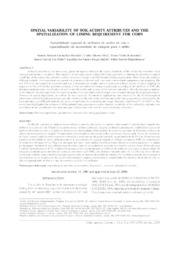Spatial variability of soil acidity attributes and the spatialization of liming requirement for corn.
Spatial variability of soil acidity attributes and the spatialization of liming requirement for corn.
Author(s): HURTADO, S. M. C.; SILVA, C. A.; RESENDE, A. V. de; PINHO, R. G. von; INÁCIO, E. dos S. B.; HIGASHIKAWA, F. S.
Summary: In Brazil, technicians, in most cases, ignore the aspects related to the spatial variability of the soil acidity attributes when liming requirement is calculated. The objective of this study was to validate the liming practice, evaluating the presence of spatial variability of the soil acidity attributes and the existence of areas with differentiated liming requirement, which were calculated by different methods. The experiment was carried out in an area cultivated with corn under conventional management and irrigation. The soil (0-0.2 m) was sampled in a conventional way (composite soil sample) and in a systematic scheme, by use of a grid sampling. In sequence to the soil fertility attributes analysis, it was calculated the liming requirement, according to the methods of SMP pH, aluminum neutralization and elevation of soil Ca and Mg levels, and increase of the soil base saturation. After the descriptive analysis of the data set was accomplished, the semivariograms were calculated and the maps were obtained through the kriging technique. Absence of spatial dependence, as well as the non necessity of limestone application, was observed for the Al neutralization calculation method. Spatial dependence was only verified for the soil acidity attributes and to the liming requirement calculated by the base saturation and SMP pH methods; for these two methods, the semivariogram ranges obtained varied from 35.7 to 200.5 m. The results have highlighted the existence of differentiated liming requirement zones when the variability of the soil acidity attributes was considered in the calculation of the dose and type of limestone to be used for corn soil acidity correction
Publication year: 2009
Types of publication: Journal article
Unit: Embrapa Maize & Sorghum
Keywords: Agricultura de Precisão, Geoestatística, Milho, Zea mays
Observation
Some of Embrapa's publications are published as ePub files. To read them, use or download one of the following free software options to your computer or mobile device. Android: Google Play Books; IOS: iBooks; Windows and Linux: Calibre.
Access other publications
Access the Agricultural Research Database (BDPA) to consult Embrapa's full library collection and records.
Visit Embrapa Bookstore to purchase books and other publications sold by Embrapa.

